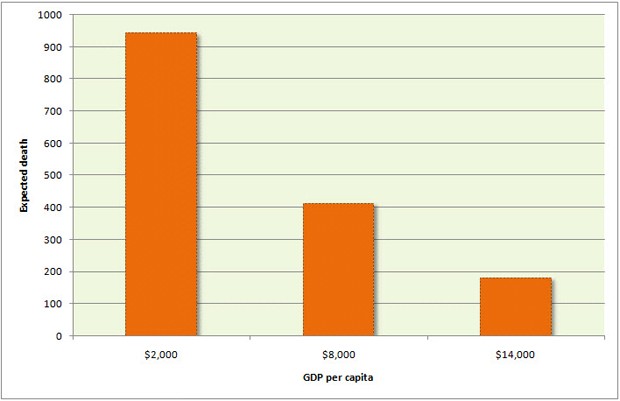
So far there are a confirmed 182 deaths from hurricane Sandy. All deaths are tragic but given New York City’s population is around 8 million, it’s a welcome relief that so far only 48 New Yorkers died as a direct result of Sandy.
That’s not likely to be the result of good luck though. It’s the result of good government, good institutions and a high standard of living.
Harvard economist Ed Glaeser argues that Sandy highlights the importance and value of good government:
Death tolls from comparable natural disasters are substantially lower in countries with more capable governments. In 2010, massive earthquakes hit both Chile and Haiti. In competent Chile, deaths numbered in the hundreds, while in chronically mismanaged Haiti, tens of thousands died.
His numbers are conservative. An estimated 300,000 people died in Haiti compared to 550 in Chile in the following month, even though the Chilean earthquake was an order of magnitude more powerful – 7.0 vs 8.8 on the (logarithmic) Richter Scale.
Professor Glaeser cites an important paper published in 2005 by Matthew Kahn from UCLA, The death toll from natural disasters: the role of income, geography and institutions. Professor Kahn begins his paper by comparing the second and third most populous countries in the world.
Between 1980 and 2002, India experienced fourteen major earthquakes that killed a total of 32,117 people while the United States experienced eighteen major earthquakes that killed only 143 people.
His key message is that “economic development provides implicit insurance” against disasters. Nations that are democratic and have “higher-quality institutions suffer less death from natural disaster.”
Professor Kahn analysed a data set of annual deaths from disasters in 73 countries between 1980 and 2002. It records more than 4,000 disaster events that resulted in the deaths of over 800,000 people.
He sought to discover how the relative number of deaths from earthquakes, floods, windstorms, extreme temperature events, landslides and industrial disasters (like Bhopal) depend on a country’s geography, income and institutions.
He found geography makes a difference. For example, African nations and those closer to the equator suffer fewer disaster events and fewer disaster-related deaths than Asian nations. Deaths are inversely related to elevation (fewer windstorms) but increase with distance from the equator (more earthquakes).
Wealth makes a bigger difference. While the income of a nation has little to do with the number of natural disasters it experiences, richer nations suffer many fewer deaths (see exhibit):
If a nation with a population of 100 million experienced a GDP per capita increase from $2,000 to $14,000, that nation would suffer 764 fewer natural-disaster deaths a year.
There’s a host of possible reasons for this. Richer countries “can provide implicit disaster insurance through effective regulation and planning and by providing quality infrastructure.”
For example, they have higher quality emergency services and better immediate and long term health care. They have better early warning systems and more durable buildings.
Good government and high social capital also make a difference (and in most cases are the foundation for higher incomes). He says less democratic nations and those with higher income inequality suffer more deaths. Corruption might lead to more deaths through “lack of enforcement of building codes, infrastructure quality, and zoning.”
Democratic nations on the other hand are more accountable and more responsive to their citizen’s welfare and desires. Moreover, “nations with stronger institutions suffer lower national death counts from disasters.”
As Professor Kahn says, his findings have implications for how the world deals with the expected increase in the frequency of natural disasters arising from climate change.
And for all its failings (e.g. New Orleans), it’s likely the US is much better equipped to deal with the long-term economic and health impact of Sandy than the Caribbean nations.
P.S. Contrary to what the Twitterverse thinks, there’ve been more deaths in the US and Canada so far from Sandy than in the Caribbean (112 vs 70 at the time of writing).








Crikey is committed to hosting lively discussions. Help us keep the conversation useful, interesting and welcoming. We aim to publish comments quickly in the interest of promoting robust conversation, but we’re a small team and we deploy filters to protect against legal risk. Occasionally your comment may be held up while we review, but we’re working as fast as we can to keep the conversation rolling.
The Crikey comment section is members-only content. Please subscribe to leave a comment.
The Crikey comment section is members-only content. Please login to leave a comment.